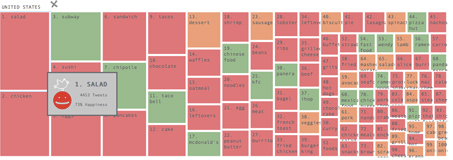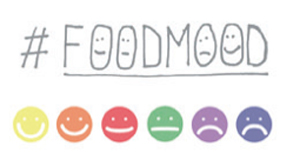If you’re on Twitter you see food tweets all day long.
“I’m so ashamed, I can’t believe I just ate a whole pizza.”
“These cupcakes are making my Monday!”
We love or hate our food and we like to talk about it. Due to these truths a new group has decided to use tweets to create a powerful infographic about our food consumption and its impact on our emotions.
FoodMood is a project that has created a graphic based off of food tweets. In a nutshell, they used Twitter to establish what people are eating and how they feel about it. FoodMood then overlaps the data with the current Gross Domestic Product information and the current obesity data to create a very user-friendly and helpful guide. Users can see the trends with a simple glance. This info allows for a deeper understanding of our eating habits.
The info is interesting. According to FoodMood the “happiest” food is lobster followed closely by cake. Snacks tend to be the most unhappy foods. Apparently, lobster tweets are always happy and we’re not praising our snacks at all.
What does all of this easy-to-read data have to do with the obesity trends? According to the FoodMood website, they believe their tool shows connections in our consumption that others have failed to notice before.
“As a sentiment analysis tool, FoodMood develops a more informed global picture about food and emotion. As a data visualization project, FoodMood shows the connections, patterns and relationships that exist between the variables — insights that are otherwise practically infeasible. Ultimately, FoodMood helps reveal a hidden layer of digital and social data that pushes the boundaries of awareness and understanding of our surroundings one step further.”
 As of right now, FoodMood only uses English tweets. As they expand they hope to provide a true global picture of the connection between our food and our emotions. Danielle Gould at foodandtechconnect.com laid out some great stats that FoodMood has gathered:
As of right now, FoodMood only uses English tweets. As they expand they hope to provide a true global picture of the connection between our food and our emotions. Danielle Gould at foodandtechconnect.com laid out some great stats that FoodMood has gathered:
- Meat consumption is high globally and usually associated with a positive sentiment.
- In most countries, fast-food brands dominate food Tweets, but sentiment ratings vary by country.
- The majority of the most-Tweeted foods globally are high on the glycemic index, and high in fat and sugar, which are all connected to obesity rates.
- They’ve found no connection between wealth and happiness when it comes to food.
The data is young, but so very interesting. The next time you share your sentiments about your burrito or your steak dinner on Twitter, just know you’re helping fuel global research.
Also Read:
10 Ways Pinterest Supports Weight Loss

